最強(qiáng)總結(jié),必會的十大機(jī)器學(xué)習(xí)算法!
1.線性回歸
線性回歸(Linear Regression)是最基本的回歸分析方法之一,旨在通過線性模型來描述因變量(目標(biāo)變量)與自變量(特征變量)之間的關(guān)系。
線性回歸假設(shè)目標(biāo)變量 y 與特征變量 X 之間呈現(xiàn)線性關(guān)系,模型公式為:
其中:

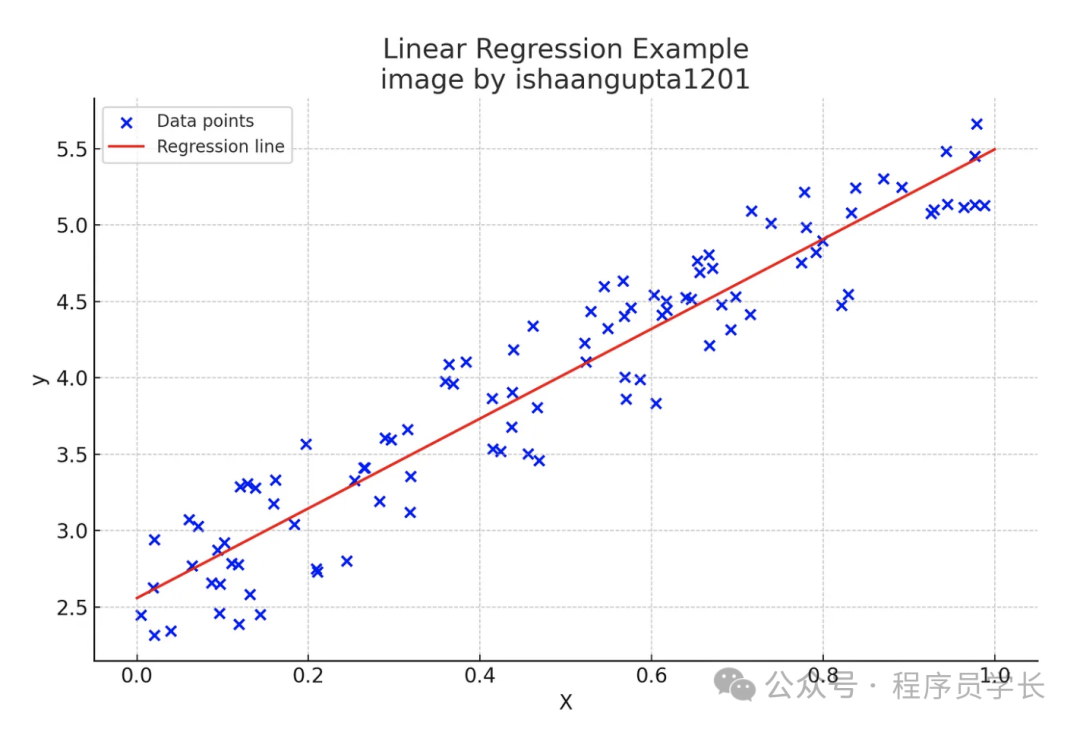 圖片
圖片
線性回歸的目標(biāo)是找到最優(yōu)的回歸系數(shù) ,使得預(yù)測值與實(shí)際值之間的差異最小。
# Importing Libraries
import numpy as np
from sklearn.linear_model import LinearRegression
import matplotlib.pyplot as plt
# ensures that the random numbers generated are the same every time the code runs.
np.random.seed(0)
#creates an array of 100 random numbers between 0 and 1.
X = np.random.rand(100, 1)
#generates the target variable y using the linear relationship y = 2 + 3*X plus some random noise. This mimics real-world data that might not fit perfectly on a line.
y = 2 + 3 * X + np.random.rand(100, 1)
# Create and fit the model
model = LinearRegression()
# fit means it calculates the best-fitting line through the data points.
model.fit(X, y)
# Make predictions
X_test = np.array([[0], [1]]) #creates a test set with two points: 0 and 1
y_pred = model.predict(X_test) # uses the fitted model to predict the y values for X_test
# Plot the results
plt.figure(figsize=(10, 6))
plt.scatter(X, y, color='b', label='Data points')
plt.plot(X_test, y_pred, color='r', label='Regression line')
plt.legend()
plt.xlabel('X')
plt.ylabel('y')
plt.title('Linear Regression Example\nimage by ishaangupta1201')
plt.show()
print(f"Intercept: {model.intercept_[0]:.2f}")
print(f"Coefficient: {model.coef_[0][0]:.2f}")2.邏輯回歸
邏輯回歸(Logistic Regression)雖然帶有“回歸”之名,但其實(shí)是一種廣義線性模型,常用于二分類問題。
邏輯回歸的核心思想是通過邏輯函數(shù)(Logistic Function),將線性回歸模型的輸出映射到區(qū)間 (0, 1) 上,來表示事件發(fā)生的概率。
對于一個(gè)給定的輸入特征 x,模型預(yù)測為:
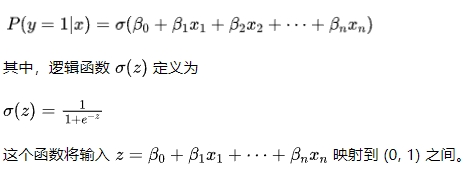
 圖片
圖片
import numpy as np
from sklearn.linear_model import LogisticRegression
# Sample data: hours studied and pass/fail outcome
hours_studied = np.array([1, 2, 3, 4, 5, 6, 7, 8, 9, 10]).reshape(-1, 1)
outcome = np.array([0, 0, 0, 0, 0, 1, 1, 1, 1, 1])
# Create and train the model
model = LogisticRegression()
model.fit(hours_studied, outcome)
# This results in an array of predicted binary outcomes (0 or 1).
predicted_outcome = model.predict(hours_studied)
# This results in an array where each sub-array contains two probabilities: the probability of failing and the probability of passing.
predicted_probabilities = model.predict_proba(hours_studied)
print("Predicted Outcomes:", predicted_outcome)
print("Predicted Probabilities:", predicted_probabilities)3. 決策樹
決策樹是一種基于樹結(jié)構(gòu)的監(jiān)督學(xué)習(xí)算法,可用于分類和回歸任務(wù)。
決策樹模型由節(jié)點(diǎn)和邊組成,每個(gè)節(jié)點(diǎn)表示一個(gè)特征或決策,邊代表根據(jù)特征值分裂數(shù)據(jù)的方式。樹的葉子節(jié)點(diǎn)對應(yīng)最終的預(yù)測結(jié)果。
決策樹通過遞歸地選擇最佳的特征進(jìn)行分裂,直到所有數(shù)據(jù)被準(zhǔn)確分類或滿足某些停止條件。常用的分裂標(biāo)準(zhǔn)包括信息增益(Information Gain)和基尼指數(shù)(Gini Index)。
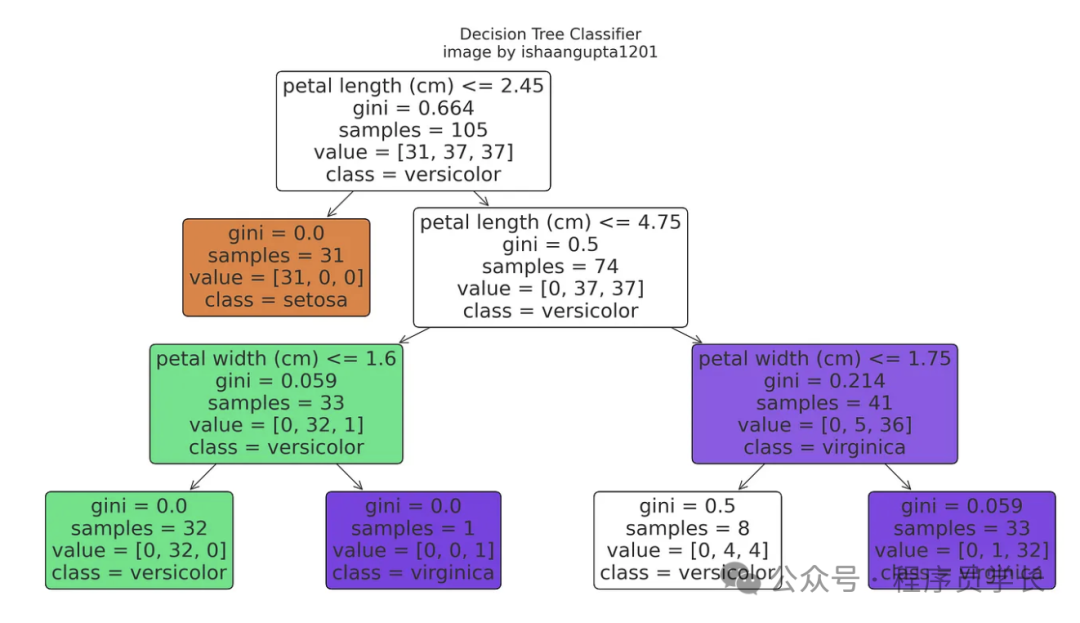 圖片
圖片
from sklearn.tree import DecisionTreeClassifier, plot_tree
from sklearn.datasets import load_iris
from sklearn.model_selection import train_test_split
from sklearn.metrics import accuracy_score, classification_report
# Load the iris dataset
iris = load_iris()
X, y = iris.data, iris.target
# splits the data into training and testing sets. 30% of the data is used for testing (test_size=0.3), and the rest for training. random_state=42 ensures the split is reproducible.
X_train, X_test, y_train, y_test = train_test_split(X, y, test_size=0.3, random_state=42)
# creates a decision tree classifier with a maximum depth of 3 levels and a fixed random state for reproducibility.
model = DecisionTreeClassifier(max_depth=3, random_state=42)
model.fit(X_train, y_train)
# Make predictions
y_pred = model.predict(X_test)
# Evaluate the model
accuracy = accuracy_score(y_test, y_pred) #calculates the accuracy of the model’s predictions.
print(f"Accuracy: {accuracy:.2f}")
print("\nClassification Report:")
print(classification_report(y_test, y_pred, target_names=iris.target_names))
# Visualize the tree
plt.figure(figsize=(20,10))
plot_tree(model, feature_names=iris.feature_names, class_names=iris.target_names, filled=True, rounded=True)
plt.show()4.支持向量機(jī)
支持向量機(jī) (SVM) 是一種監(jiān)督學(xué)習(xí)算法,可用于分類或回歸問題。
SVM 的核心思想是找到一個(gè)超平面,將數(shù)據(jù)點(diǎn)分成不同的類,并且這個(gè)超平面能夠最大化兩類數(shù)據(jù)點(diǎn)之間的間隔(Margin)。
超平面
超平面是一個(gè)能夠?qū)⒉煌悇e的數(shù)據(jù)點(diǎn)分開的決策邊界。
在二維空間中,超平面就是一條直線;在三維空間中,超平面是一個(gè)平面;而在更高維空間中,超平面是一個(gè)維度比空間低一維的幾何對象。
形式上,在 n 維空間中,超平面可以表示為。

在 SVM 中,超平面用于將不同類別的數(shù)據(jù)點(diǎn)分開,即將正類數(shù)據(jù)點(diǎn)與負(fù)類數(shù)據(jù)點(diǎn)分隔開。
支持向量
支持向量是指在分類問題中,距離超平面最近的數(shù)據(jù)點(diǎn)。
這些點(diǎn)在 SVM 中起著關(guān)鍵作用,因?yàn)樗鼈冎苯佑绊懙匠矫娴奈恢煤头较颉?/span>
間隔
間隔(Margin)是指超平面到最近的支持向量的距離。
最大間隔
最大間隔是指支持向量機(jī)在尋找超平面的過程中,選擇能夠使正類和負(fù)類數(shù)據(jù)點(diǎn)之間的間隔最大化的那個(gè)超平面。
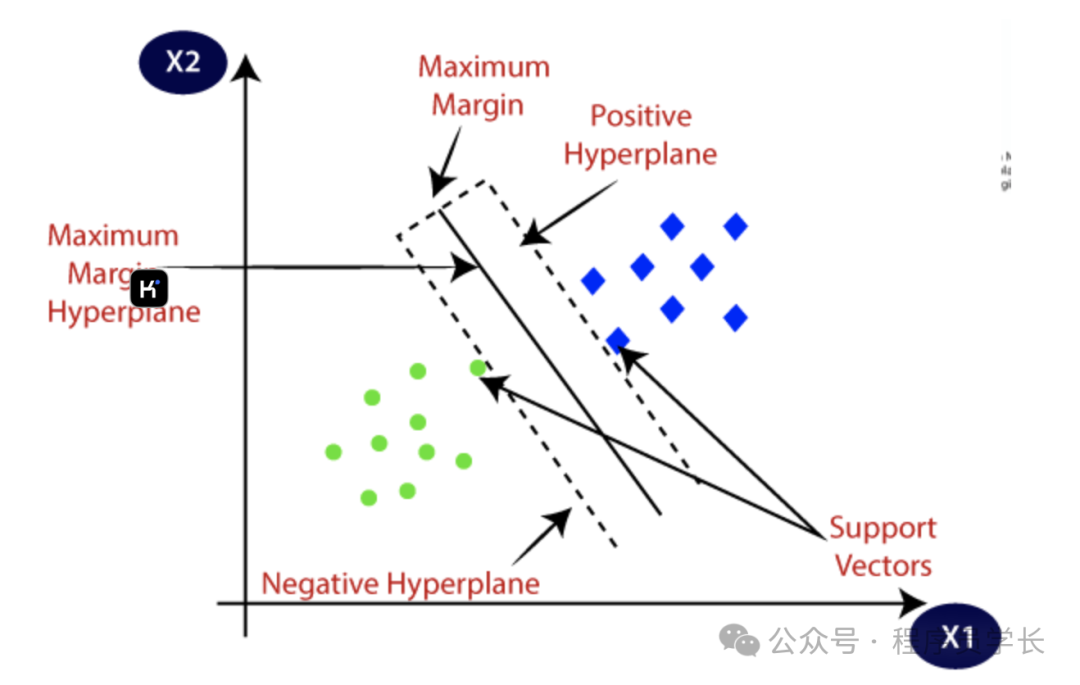 圖片
圖片
from sklearn.datasets import load_wine
from sklearn.svm import SVC
from sklearn.model_selection import train_test_split
# Load the wine dataset
X, y = load_wine(return_X_y=True)
# Split the data into training and testing sets
X_train, X_test, y_train, y_test = train_test_split(X, y, test_size=0.2, random_state=42)
# Create and train the model
model = SVC(kernel='linear', random_state=42)
model.fit(X_train, y_train)
# Make predictions
y_pred = model.predict(X_test)
print("Predictions:", y_pred)5.樸素貝葉斯
樸素貝葉斯是一種基于貝葉斯定理的簡單而強(qiáng)大的分類算法,廣泛用于文本分類、垃圾郵件過濾等問題。
其核心思想是假設(shè)所有特征之間相互獨(dú)立,并通過計(jì)算每個(gè)類別的后驗(yàn)概率來進(jìn)行分類。
貝葉斯定理定義為


from sklearn.datasets import load_digits
from sklearn.naive_bayes import GaussianNB
from sklearn.model_selection import train_test_split
# Load the digits dataset
X, y = load_digits(return_X_y=True)
# Split the data into training and testing sets
X_train, X_test, y_train, y_test = train_test_split(X, y, test_size=0.2, random_state=42)
# Create and train the model
model = GaussianNB()
model.fit(X_train, y_train)
# Make predictions
y_pred = model.predict(X_test)
print("Predictions:", y_pred)6.KNN
K-Nearest Neighbors (KNN) 是一種簡單且直觀的監(jiān)督學(xué)習(xí)算法,通常用于分類和回歸任務(wù)。
它的基本思想是:給定一個(gè)新的數(shù)據(jù)點(diǎn),算法通過查看其最近的 K 個(gè)鄰居來決定這個(gè)點(diǎn)所屬的類別(分類)或預(yù)測其值(回歸)。
KNN 不需要顯式的訓(xùn)練過程,而是直接在預(yù)測時(shí)利用整個(gè)訓(xùn)練數(shù)據(jù)集。
 圖片
圖片
算法步驟
- 步驟1
選擇參數(shù) K,即最近鄰居的數(shù)量。 - 步驟2
計(jì)算新數(shù)據(jù)點(diǎn)與訓(xùn)練數(shù)據(jù)集中所有點(diǎn)之間的距離。
常用的距離度量包括歐氏距離、曼哈頓距離、切比雪夫距離等。 - 步驟3
根據(jù)計(jì)算出的距離,找出距離最近的 K 個(gè)點(diǎn)。 - 步驟4
對于分類問題,通過對這 K 個(gè)點(diǎn)的類別進(jìn)行投票,選擇得票最多的類別作為新數(shù)據(jù)點(diǎn)的預(yù)測類別。
對于回歸問題,計(jì)算這 K 個(gè)點(diǎn)的平均值,作為新數(shù)據(jù)點(diǎn)的預(yù)測值。 - 步驟5
返回預(yù)測結(jié)果。
from sklearn.datasets import load_iris
from sklearn.neighbors import KNeighborsClassifier
from sklearn.model_selection import train_test_split
# Load the iris dataset
X, y = load_iris(return_X_y=True)
# Split the data into training and testing sets
X_train, X_test, y_train, y_test = train_test_split(X, y, test_size=0.2, random_state=42)
# Create and train the model
model = KNeighborsClassifier(n_neighbors=3)
model.fit(X_train, y_train)
# Make predictions
y_pred = model.predict(X_test)
print("Predictions:", y_pred)7.K-Means
K-Means 是一種流行的無監(jiān)督學(xué)習(xí)算法,主要用于聚類分析。
它的目標(biāo)是將數(shù)據(jù)集分成 K 個(gè)簇,使得每個(gè)簇中的數(shù)據(jù)點(diǎn)與簇中心的距離最小。
算法通過迭代優(yōu)化來達(dá)到最優(yōu)的聚類效果。
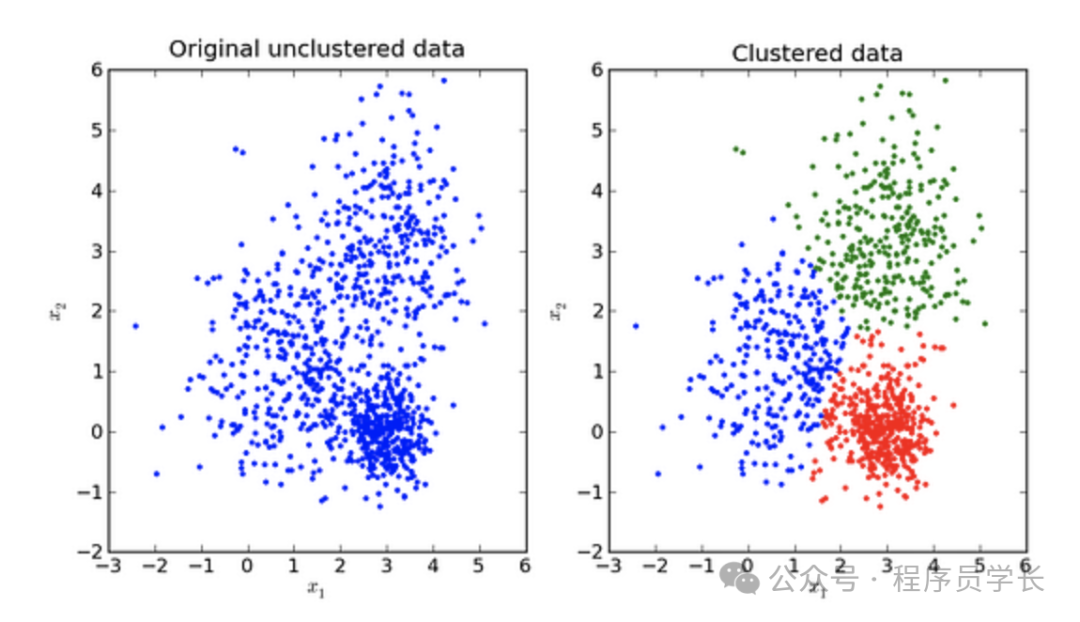 圖片
圖片
算法步驟
- 步驟1
初始化 K 個(gè)簇中心(質(zhì)心)。可以隨機(jī)選擇數(shù)據(jù)集中的 K 個(gè)點(diǎn)作為初始質(zhì)心。 - 步驟2
對于數(shù)據(jù)集中每個(gè)數(shù)據(jù)點(diǎn),將其分配到與其距離最近的質(zhì)心所在的簇。 - 步驟3
重新計(jì)算每個(gè)簇的質(zhì)心,即簇中所有點(diǎn)的平均值。 - 步驟4
重復(fù)步驟2和步驟3,直到質(zhì)心不再變化或變化量小于設(shè)定的閾值。
from sklearn.datasets import make_blobs
from sklearn.cluster import KMeans
# Create a synthetic dataset
X, _ = make_blobs(n_samples=100, centers=3, n_features=2, random_state=42)
# Create and train the model
model = KMeans(n_clusters=3, random_state=42)
model.fit(X)
# Predict the clusters
labels = model.predict(X)
print("Cluster labels:", labels)8.隨機(jī)森林
隨機(jī)森林 (Random Forest) 是一種集成學(xué)習(xí)方法,主要用于分類和回歸任務(wù)。
它通過結(jié)合多個(gè)決策樹的預(yù)測結(jié)果來提高模型的泛化能力和魯棒性。
隨機(jī)森林的核心思想是通過引入隨機(jī)性來構(gòu)建多個(gè)不同的決策樹模型,然后對這些模型的預(yù)測結(jié)果進(jìn)行投票或平均,從而獲得最終的預(yù)測結(jié)果。
 圖片
圖片
算法步驟
- 步驟1
從訓(xùn)練數(shù)據(jù)集中隨機(jī)抽取多個(gè)子樣本(使用有放回的抽樣方法,即Bootstrap抽樣),每個(gè)子樣本用于訓(xùn)練一個(gè)決策樹。 - 步驟2
對于每個(gè)決策樹,在構(gòu)建過程中,節(jié)點(diǎn)的劃分使用隨機(jī)選擇的一部分特征,而不是全部特征。 - 步驟3
每棵樹獨(dú)立生長,直到其無法進(jìn)一步分裂,或者達(dá)到了某個(gè)預(yù)設(shè)的停止條件(如樹的最大深度)。 - 步驟4
對于分類任務(wù),最終的預(yù)測結(jié)果由所有樹的投票結(jié)果決定(多數(shù)投票法);對于回歸任務(wù),預(yù)測結(jié)果為所有樹的預(yù)測值的平均值。
from sklearn.datasets import load_breast_cancer
from sklearn.ensemble import RandomForestClassifier
from sklearn.model_selection import train_test_split
# Load the breast cancer dataset
X, y = load_breast_cancer(return_X_y=True)
# Split the data into training and testing sets
X_train, X_test, y_train, y_test = train_test_split(X, y, test_size=0.2, random_state=42)
# Create and train the model
model = RandomForestClassifier(random_state=42)
model.fit(X_train, y_train)
# Make predictions
y_pred = model.predict(X_test)
print("Predictions:", y_pred)9.PCA
主成分分析 (PCA) 是一種用于數(shù)據(jù)降維的統(tǒng)計(jì)技術(shù)。
其主要目的是通過將數(shù)據(jù)從高維空間映射到一個(gè)低維空間中,保留盡可能多的原始數(shù)據(jù)的方差。
這對于數(shù)據(jù)預(yù)處理和可視化非常有用,尤其是在處理具有大量特征的數(shù)據(jù)集時(shí)。
PCA 的核心思想是找到數(shù)據(jù)中的“主成分”(即那些方差最大且相互正交的方向),并沿著這些方向投影數(shù)據(jù),從而降低數(shù)據(jù)的維度。
通過這種方式,PCA 可以在減少數(shù)據(jù)維度的同時(shí)盡可能保留數(shù)據(jù)的整體信息。
from sklearn.datasets import load_digits
from sklearn.decomposition import PCA
# Load the digits dataset
X, y = load_digits(return_X_y=True)
# Apply PCA to reduce the number of features
pca = PCA(n_compnotallow=2)
X_reduced = pca.fit_transform(X)
print("Reduced feature set shape:", X_reduced.shape)10.xgboost
XGBoost(Extreme Gradient Boosting)是一種基于梯度提升框架的高效、靈活的機(jī)器學(xué)習(xí)算法。
它是梯度提升決策樹 (GBDT) 的一種實(shí)現(xiàn),具有更高的性能和更好的可擴(kuò)展性,常被用來處理結(jié)構(gòu)化或表格數(shù)據(jù),并在各種數(shù)據(jù)競賽中表現(xiàn)優(yōu)異。
XGBoost 的核心思想是通過迭代構(gòu)建多個(gè)決策樹,每個(gè)新樹都嘗試糾正前一個(gè)樹的誤差。最終的預(yù)測結(jié)果是所有樹的預(yù)測結(jié)果的加權(quán)和。
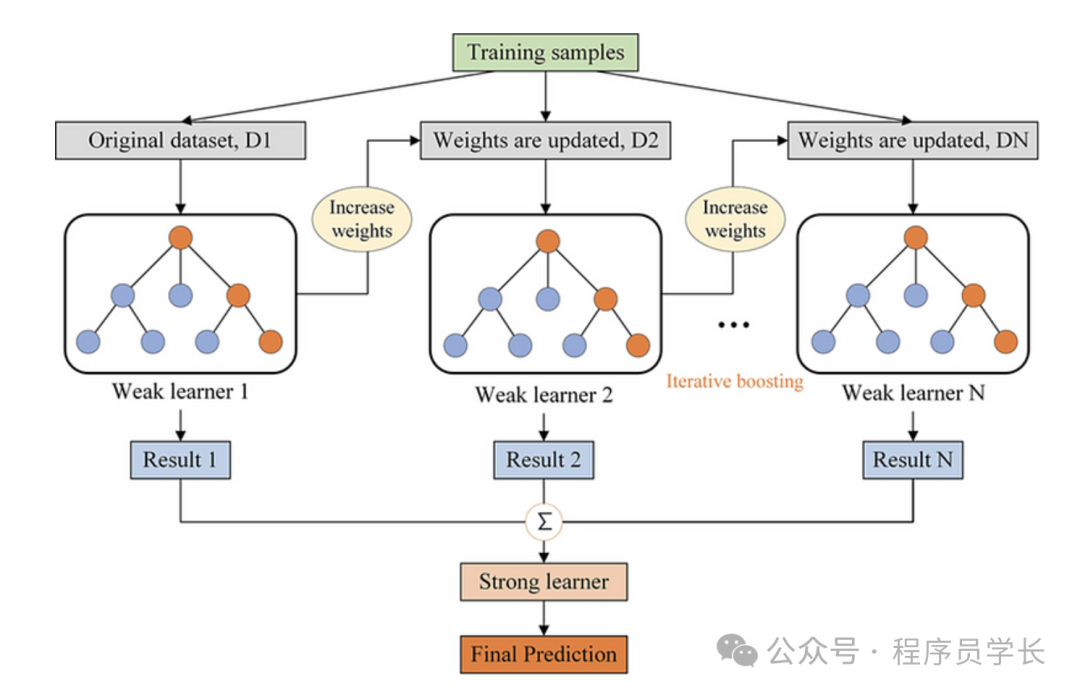 圖片
圖片
import xgboost as xgb
from sklearn.datasets import load_breast_cancer
from sklearn.model_selection import train_test_split
# Load the breast cancer dataset
X, y = load_breast_cancer(return_X_y=True)
# Split the data into training and testing sets
X_train, X_test, y_train, y_test = train_test_split(X, y, test_size=0.2, random_state=42)
# Create and train the model
model = xgb.XGBClassifier(random_state=42)
model.fit(X_train, y_train)
# Make predictions
y_pred = model.predict(X_test)
print("Predictions:", y_pred)





































